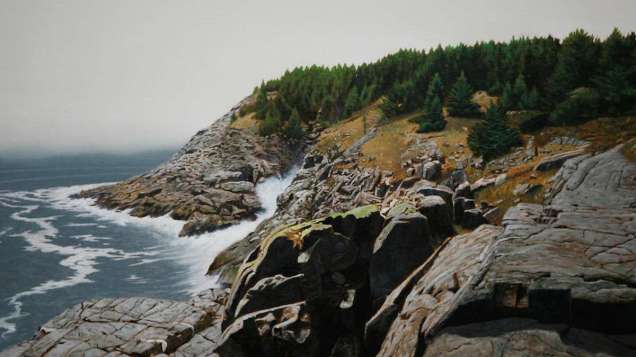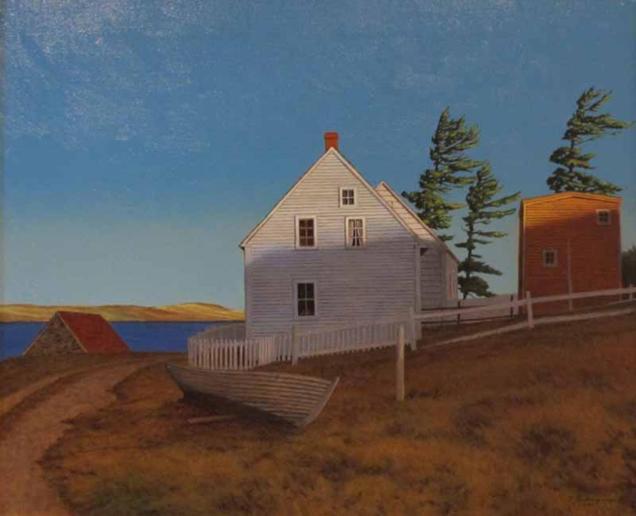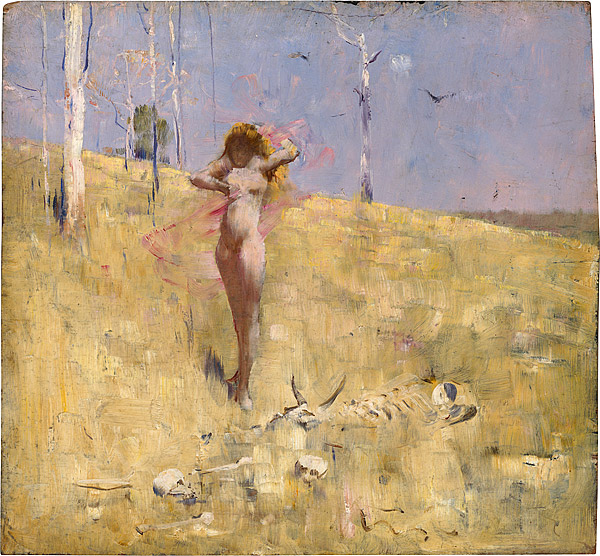René François Xavier Prinet (1861-1946) is a bit forgotten. He doesn’t have an English Wikipedia page. Who will write it?





René François Xavier Prinet (1861-1946) is a bit forgotten. He doesn’t have an English Wikipedia page. Who will write it?





These two paintings were made the same year, 1863. The first one (The Birth of Venus, by Cabanel) was a huge success and was bought by the Emperor Napoléon III. The second one (Olympia, by Manet) was a huge shock and scandal.
It’s a perfect example of the confrontation between classic and modern…
Manet is often called “The first modernist painter”. I’ll talk in another article about this painting, but let’s be quick : there are at least two transgressions here.
Wikipedia :
The painting deviates from the academic canon in its style, characterized by broad, quick brushstrokes, studio lighting that eliminates mid-tones, large color surfaces and shallow depth. Unlike the smooth idealized nude of Alexandre Cabanel’s La naissance de Vénus, also painted in 1863, Olympia is a real woman whose nakedness is emphasized by the harsh lighting. The canvas alone is 51.4 x 74.8 inches, which is rather large for this genre-style painting. Most paintings that were this size depicted historical or mythological events, so the size of the work, among other factors, caused surprise. Finally, Olympia is fairly thin by the artistic standards of the time and her relatively undeveloped body is more girlish than womanly.
(…both are in the Musée d’Orsay, in Paris. If you want to visit the city one day…)


In this article, I watch the second transgression. From him, we begin to really SEE the brush strokes. A painting like this invites you to THINK instead just feeling happy because it’s beautiful.
Look at the chairs and the characters in the front of the Tuileries park in Paris. They are normal. But the trees and the crowd are just… stains.
He opened the way to impressionism…

“What I seek before all else in a painting is a man, not a painting.”
Emile Zola
Hitchcock and Wilder, as movie makers, always said that they don’t want to push the audience in a dream, but invent stories or events strange enough to make the audience AWARE it’s a film, to have fun with them. Hitchcock always appears in his films, which is an example.
Brian de Palma (cinema) works like Brecht (theater) about distancing effects, things (like a split screen) which will make break the cinema-dream to put you out and make you think.
https://en.wikipedia.org/wiki/Distancing_effect
Tool :
Yes it’s a tool, useful for today. Whatever your field, how can you do to use it? Is “Making people aware of the form” modernity? What are the other criterions?
In a post-modern era, or if your audience IS aware, what happens? You use irony, geeky references? How does it work? How can it be boring? How does it fail?
Hmmm. Sorry I have to stop and go to bed.
Thank you for reading!

Hester Berry has a web page. She grew up in Devon, the South West of England.
I really don’t know how she is categorized, but I’d like to invent hyper-impressionism.
You’ll quickly understand her trick : landscapes made with quick painting knives… spots.
If you look closely, it’s abstract art.
If you half-close your eyes, of if you look from a mile away, you see a landscape.
(it’s why I chose for once to present her work in the stamps mode)
“Heeyyyyyy cheater, this is tricky!”.
Bah, I love that. She captures something. She is probably very fast (but I’m not that sure). She has to think a lot before attacking, right?
And prepare colors…
Thanks for reading!
Eugen Dücker, “romanticist Baltic German painter”, yes all that.
Some painters amaze you. Some are intriguing! Some have something you like : you feel something, or you feel the mood of their work, or you’re amused by “what he does”.
Dücker works well with light, that’s all. The sense of the place. You try to imagine the wind, the birds, the sounds around. Nothing more. No revolution. Just good academic painting…
I love 1 to 4. What about you?
https://en.wikipedia.org/wiki/Eugen_D%C3%BCcker









https://en.wikipedia.org/wiki/Fitz_Henry_Lane
Fitz Henry Lane (1804-1865) was a “luminist” painter. He painted… mostly boats.
He’s on my border, this is why I put him here…
Above this border, it’s too academic, therefore boring. In Art, I like the “Hey this is new!” state, raising eyebrows, etc.
Nothing like that with Lane! But there’s this I-don’t-know-what which makes me watch more. Like the hesitating emoji holding his chin…
“Too wise”. “Too conventional”. “Lack of energy”. “Lack of surprises”. “Bland”. “Pff”.
Eyes want to roll. But they don’t.
Thus I wrote this article to think about this pattern : when you watch something you find “too conventional BUT”.
“Nope. Wait a minute…” : this, in loop.
Therefore, where is it? Where is this frontier? Aesthetics? Mood? Light? What about choices? What about other arts? What’s this loop in… propositions? In poetry? What is a music you don’t like BUT you want to stick on it to find what you “do like, though”? What is to be on this border? Is it lukewarm? Could this hesitation be useful? For what?
Thanks for reading!




http://sarazhin-denis.com/catalog/paintings
https://www.instagram.com/denis_sarazhin
Denis Sarazhin (he’s born in 1982) has a style. He seems to be obsessed by hands, and long twisted bodies. He has something of Vroubel, of Segantini.
Have a great day!








V. Hammershøi (1864-1916) was a Danish painter who, in the splendid middle of modernity, stayed in conservatism.
The core of Art, says G. Deleuze, is “What newness does it bring?”. It’s essential, of course, and any good Art History focuses on this force of progress. Art is moving forward. Each important artist, in music or painting, brought something new.
On all the keyboard of a discipline, the “newness” is very funny to study. It’s why I am currently reading a Manet biography. It’s why I love Fellini or Godard in cinema, or Bartok and Debussy in classical music.
Jubilation, it is what you get in front of invention.
But.
There’s always a time when you see there’s a rock in the current.
Well, there’s a pleasure in Art exploration in seeing the one who stays behind, in “his style”, when the whole “correct” colleagues seems to push forward. Hammershøi? It was the time of Van Gogh and Cézanne!
As for every domain, it’s splendid to study “conservatives”. To find out why, what were their motivations. “Where” they were evolving all the same. What they said, wrote, decided. Were they aware of the progresses outside? What they did from the movements they saw. Little elements? A slight change? Nothing at all?
Are and when these artist are re-discovered?
I what other domains should we sometimes watch the unevolving strong rocks in the current? Why? What do we learn?
Thanks for reading!

I’ve a problem with Ben Aronson. His work always makes me balance like a pendulum, between :
Therefore I keep watching. His flowers are gorgeous. I admit he “felt” Paris’ streets. I like when he’s attracted to more abstraction. I like this paradox, it’s realistic but not at all : there’s a pendulum with expressionism, a speed, a movement. It’s realistic from afar, but not at all if you look closer…
Thanks for reading!
JP










http://www.petersculthorpe.com/
Classical, meticulous, American. I’m unable to say what I like in this work. Sculthorpe is a good technician. He paints a lot (I found plenty on the web). I think I liked the first one very much, then I searched a lot for others.
Many painters have an “intention” – and we love that! But he seems to want just to show us how it is. It’s so quiet…
Though it looks like photography, there’s something different. A slight something (look at the first one, this night…). Nevertheless, it’s not haunting like Wyeth.
I don’t know. I love the way he loves the light. What do you think?
Have a nice day!
Jean-Pascal










Raoul Hynckes (1893-1973) was a Dutch/Belgian painter. Long life, different styles! Impressionism, still lifes, and then “this” realism I love so much : trying to capture the soul or the moment of a place. Yes, like Stephen Shore did at times in the USA…
There’s nobody, only places. These places say something, right? I love his sunny/shade work…
Have a nice day!
https://en.wikipedia.org/wiki/Raoul_Hynckes






“It is not enough to know your craft – you have to have feeling. Science is all very well, but for us imagination is worth far more”.
“There is only one true thing: Instantly paint what you see”.
“But to have spontaneity, one must be master of his art”.
Edouard Manet
These are good little seeds for artists, thinkers, and artists thinkers.
The middle one is linked to the 1st & 3rd.
The pack is like a loop, right? 1 – 2 – 3 then again. A braid.
Tool :
What’s your braid? When you write a poem, do you tell a story, do you picture a place or a mood, do you work on words as elements : jewelry or photography? If you’re a teacher, what do you weave? Watching the class, the students one by one? Do you invent, or do you follow? In jazz, do you listen to others or do you lead? What about sex? Marketing? Leading a battle? Politics? Making a speech? Being an actor? Conversation?
As always, it’s about
Thanks for reading!
Some examples :
“An artist should be a spontanéiste. There’s the right term. But to have spontaneity, one must be master of his art. Undirected groping never leads anywhere. One must translate one experiences, but translate it instantaneously, so to speak”
Manet

https://en.wikipedia.org/wiki/Anders_Zorn
Anders Zorn was a Swedish painter (1860-1920), a star in his country but I’m not sure he’s well known elsewhere. He knows his art, and when he paints water you can almost hear the sound of lapping…
There’s talent, and freedom, and he knows what a portrait is. Bravo!
Thanks for reading!
















Sydney Long (1871 – 1955) was an Australian artist. People talk about “Art Nouveau”, or “Symbolism”. You’ll read plenty about him.
What I like is… I know it’s not great, but I constantly come back to see a little more. A way of unfinishing his work. A strange tree. A nice light. Details that make me wonder all the time : Why this? Why that?










Digital Artist? Designer? Painter? I don’t know. He has a universe (countryside, dying machines, toys, megastructures), but he has “this” sense of light, mood and weather that I love.
On Wikipedia : https://en.wikipedia.org/wiki/Simon_St%C3%A5lenhag
Official Website : http://www.simonstalenhag.se/ (you’ll find his FB and Twitter there)
To buy prints : https://www.redbubble.com/fr/people/simonstalenhag
Have a nice day!












It’s about people in the 1920s, doing things you don’t understand, or posing like in front of an imaginary photograph. My eyebrows are moving up, that’s it! I kind of like the movement it triggers in my mind : a wonder, most of the time…
http://juanmartinezbengoechea.com/
Have a great day!
Jean-Pascal














Alex Coxville (1920-2013) was a Canadian painter. I like him because of the uncertain mood we often find in his work. It’s troubling but harmlessly. It’s quiet but strange. It’s daily, but like in a dream – notice his use on “there’s no shadow”. And I love his way to choose a funny point of view, hiding things we would like to see…
Here are 10 paintings :











https://en.wikipedia.org/wiki/Giovanni_Segantini was an Italian painter (1858-1899).
No genius here, and it’s maybe why I love his work so much. His “Bad Mothers” is a masterpiece. I love his way of painting the simple life of people in the mountains at the time. You can feel the wind, right? His “sense of sun” is absolutely fantastic. What a light!
OK, I shut up now : here’s what I found for you…














 Segantini
Segantini
Jean-Marie Poumeyrol was born in 1946. This French painter is said to be a “fantastic realist” (which probably must makes him smile). Symbols. Erotica. Lands. Boats…
I like him a lot for a couple or reasons : it’s gorgeous, but also enigmatic. Some paintings are like… games, riddles. You need time to see things, guess what’s happening (whose shoes are they, in the first picture?), etc…
But as usual with great artists, photographers, poets, painters : words are very, very weak to explain. So :









Carl Spitzweg was a German poet and painter. I won’t talk much about that : his paintings are DARLING. Well, yes, I think about N. Rockwell, at times. Do you? I chose five pieces but you’ll find some more easily.
Have a nice day!




